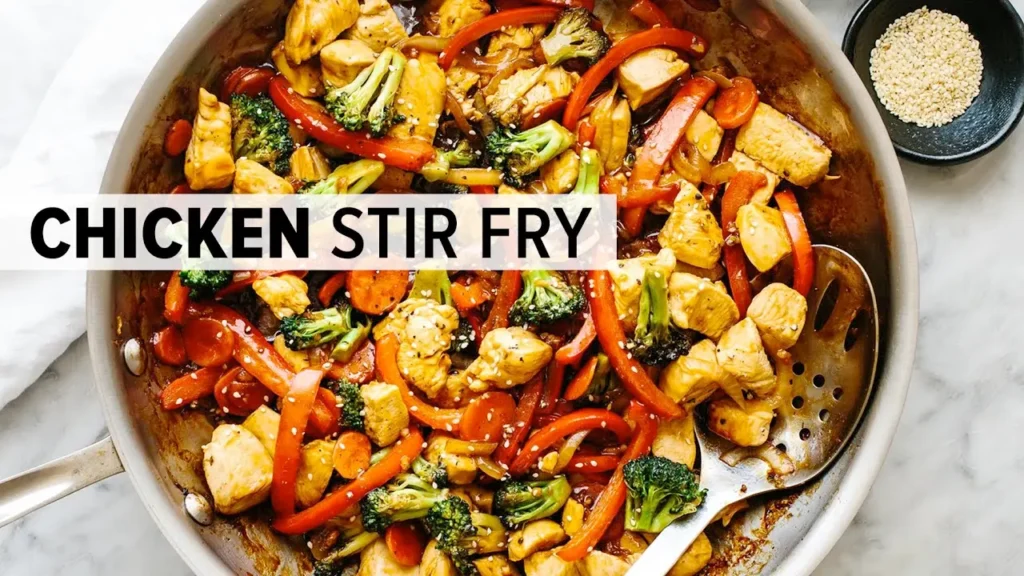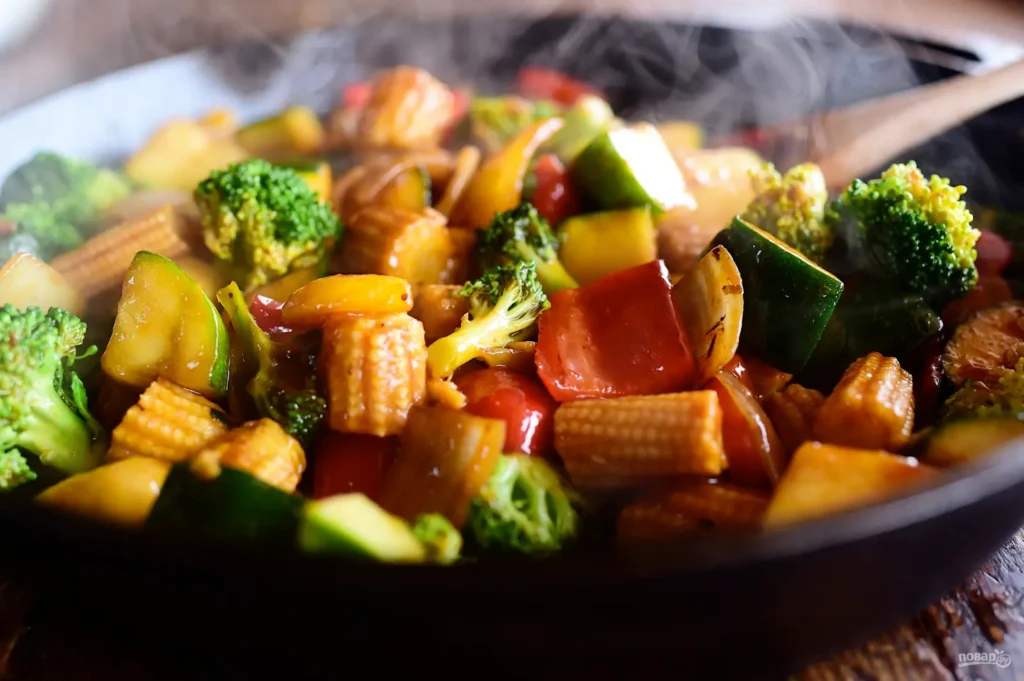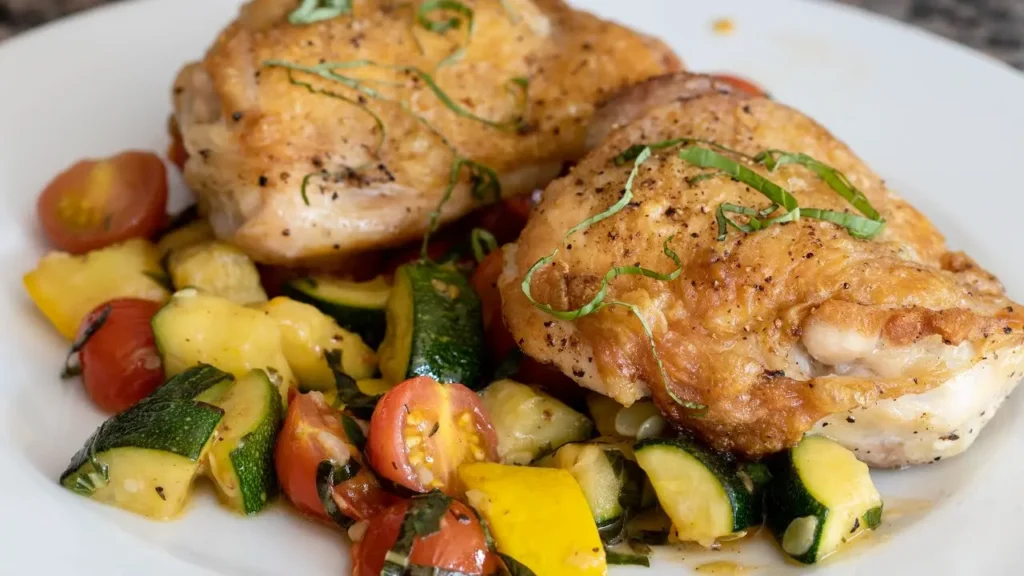Best Chicken Stir Fry Recipe with Veggies (2025)

Here is a simple and flavourful chicken stir-fry with fresh vegetables, quick, and healthy for a meal in 2025. You will find out which spices allow a dish to become hardcore, what temperature and time is the best one for every ingredient, and how to make this recipe the most suitable for you without harming your health. Whether it is a beginner’s guide or someone who wants to master a few tricks and facts about nutrition, this guide is for you, as it simplifies how you prepare a delicious stir-fry.
Why This Chicken Stir Fry Stands Out in 2025
Chicken stir fry is one of the options for a healthy and quick dinner, and it will remain so in 2025; however, the dishes must be made from fresh products, the combinations should be correct, and the dishes should have an intense taste. This recipe combines some of the contemporary practices with the traditional ones to help with mixing the ingredients. If you’re a fan of flavor-forward skillet meals, check out this recipe for pan-seared chicken thighs.
Versatility is one of its strongest features—perfect for gluten-free, keto, or high-protein diets.
It’s also incredibly prep-friendly, coming together in under 30 minutes with minimal mess.
Seasonal veggies and clean, whole ingredients (no mystery sauces here) round out this wholesome dish.
This is not just a stir-fry meal, life’s goal is to fill the stomach with tasty and wholesome food at the same time.
Essential Ingredients for Flavor-Packed Chicken Stir Fry
The special feature of a stir-fry is the freshness of the vegetables, the tender, fully finished chicken, and the chicken sauce that makes the flavor really come through. Here’s what you’ll need:
Main Ingredients:
- Boneless chicken breast or thigh (500g, thinly sliced)
- Broccoli florets (1 cup)
- Red bell pepper (1 sliced)
- Carrots (1 large, julienned)
- Sugar snap peas (1 cup)
- Garlic (3 cloves, minced)
- Fresh ginger (1 tbsp, grated)
- Sesame oil (1 tbsp)
- Olive oil or avocado oil (for cooking)
Sauce:
- Soy sauce or tamari (3 tbsp)
- Honey or maple syrup (1 tbsp)
- Rice vinegar (1 tbsp)
- Cornstarch (1 tsp for thickening)
- Water (2 tbsp)
- Red chili flakes (optional) – for heat
Garnish:
- Spring onions
- Toasted sesame seeds
- Lime wedges
To prepare chicken, whether organic or free-range, and combine fresh vegetables will make the food tastier and healthier.
Chicken Stir Fry Recipe with Veggies: Step by Step
Step 1: Prepare Ingredients
Thinly slice the chicken and veggies, then marinate all the ingredients for preparing the sauce in a bowl and let them sit aside for some time.
Step 2: Cook the Chicken
Heat oil in an enormous wok or skillet; then sauté the ginger and garlic. Then you can brown the chicken pieces in a layer; the cooking process takes about 5 to 6 minutes, and you can turn them one or two times. Remove and reserve.
Step 3: Sauté the Veggies
In the same pan, perhaps after adding a little more oil into it, fry the broccoli, carrots, and peppers for about 3-4 minutes until tender crisp; for that extra flavor, add garlic and ginger just the last five minutes before serving.
Step 4: Combine & Add Sauce
Return chicken to the pan, pour it over the veggies, and make sure it is well covered by the sauce. Stir continually until the sauce thickens.
Step 5: Garnish & Serve
Finally, it is served garnished with sesame seeds, green onions, and a little lime juice. This most specifically should be served hot with either rice or noodles, though, in case of preference, low-carb may be cauliflower rice.
Tips for Perfect Stir-Fry Texture and Taste
Stir-frying is quick, but precision matters. Here are pro tips to elevate your dish:
- High heat is key: Use a wok if possible. The hotter the pan, the better the sear.
- Don’t crowd the pan: Cook chicken in batches for even browning.
- Cut evenly: Even distribution implies that all the sections of food are equally done at the same time to the same depth.
- Don’t overcook veggies: It is a good practice to keep them very lively and fresh so that the crispness and nutrients of the food do not disappear.
- Use fresh aromatics: Garlic and ginger are unbeatable when it comes to giving that special flavor, of which the powdered type must not be used at all.
Best Vegetables to Use in Stir-Fry
One cannot overstate how versatile stir-fry is; it can be prepared and garnished in thousands of ways. As much as the arrangement of the vegetables is concerned, all efforts should be made to group foods that are in season or those that are available in the refrigerator.
It is laudable to stick to the tried and true, like broccoli. It remains so crisp that they add fiber and vitamin C to your plate when you are done preparing them. It is juicy and crunchy in texture, full of antioxidants, and the bell peppers provide that much-needed colorful addition. Carrots are sweet and crisp, thus the perfect counterbalance to richer ingredients such as meat, and beneficial to vision.

Snap peas are another winner. They’re delicate in texture and can be slightly sweet, in addition to being packed with folate and vitamin K. For those seeking something a little heftier, mushrooms give it a meaty feel and a boost of the fifth taste, umami, without a lot of calories. Baby corn makes a funny, sweet, crunchy snack; on the other hand, the zucchini is a little softer and good for boiling and low-carb diets.
What you have to avoid are vegetables that have a high water content, such as tomatoes or cucumbers. Though they can be used, the sauce should be adjusted to balance with the water.
How to Customize for Dietary Needs
This chicken stir-fry is naturally adaptable. Here’s how to adjust it:
- Gluten-free: Instead of soy sauce, use tamari or coconut aminos in your diet.
- Low-carb/keto: Do not use cornstarch; instead, opt for xanthan gum or arrowroot powder. You can have it served over zucchini noodles or cauliflower rice as well.
- Vegetarian/Vegan: It acts as an excellent substitute for chicken, tofu, tempeh, and mushrooms.
- Low-sugar: Leave out the honey and use a few drops of lemon juice for a toned-down version.
If you’re looking to expand your repertoire, try this go-to chicken and Parma ham recipe.
There are some ways to make this dish a little more compatible with one’s goals while at the same time keeping the deliciousness intact.
Common Mistakes to Avoid When Making Stir-Fry
Even seasoned cooks make these errors. Here’s what to avoid:
- Overcrowding the pan: Causes steaming, not stir-frying.
- Using low heat: Won’t caramelize the sauce or sear the meat.
- Do not prep beforehand: Stir-fry is fast, so have everything ready.
- Overcooking the veggies: They should be vibrant and crisp, not soggy.
- Sauce too watery: Use cornstarch and boil briefly to thicken.
Storage and Reheating Tips
Meal-prepping or saving leftovers? Follow these tips:
- Storage: Keep in airtight containers in the fridge for up to 4 days.
- Freezing: Freeze portions for up to 2 months. Reheat from frozen in a pan with a splash of water.
- Reheating: Avoid microwaving to preserve texture. Pan heat is best.
Pro tip: Store sauce separately if you want to keep veggies crisp.
Why This Stir-Fry is Good for You
It’s delicious and full of vitamins and a good mixture of complex carbohydrates and protein.
Nutrient | Source | Benefit |
Protein | Chicken | Muscle repair, satiety |
Fiber | Veggies | Gut health, blood sugar control |
Vitamin A | Carrots, peppers | Vision, immunity |
Vitamin C | Broccoli, peppers | Skin health, iron absorption |
Healthy fats | Sesame, olive oil | Brain and heart health |
Perfect for clean eating or just getting more real food into your diet.

Final Thoughts
Chicken stir fry and the way it is used in the year 2025 is not as simple as ‘chopping and dropping into the pan’. Basically, go through the following steps, and you will be able to enjoy a much better quality of food at home than you could get in any restaurant.
FAQs
How to make a good stir-fried chicken?
It is important to ensure that they are broiled, sliced, portioned, and served with an appetizing sauce prepared using the appropriate amount of spices.
What are some important facts about stir-frying?
The details of stir-frying are: high temperature, chop everything, and then divide into pieces so that they do not become steamed.
Can soy sauce be replaced with anything else?
Yes, the substitutes can be tamari, coconut aminos, and liquid aminos.
